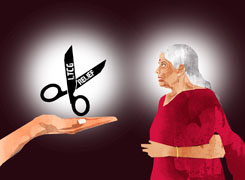Ramalingam Kalirajan |10924 Answers |Ask -Follow
Mutual Funds, Financial Planning Expert - Answered on May 17, 2024
He has an MBA in finance from the University of Madras and is a certified financial planner.
He is the director and chief financial planner at Holistic Investment, a Chennai-based firm that offers financial planning and wealth management advice.... more

Hello sir. I want to build emergency fund. I can save 5,000 ? for month.I wish to build upto 3,00,0000 ? for my emergency needs. Kindly suggest better options for Emergency Fund.
Setting Your Goal
You aim to build an emergency fund of 3,00,000 rupees. This will take some time and discipline, but it is achievable. Here are some strategies and options to help you build your emergency fund.
Savings Accounts
A traditional savings account is a safe and easily accessible option. While the interest rates are relatively low, the security and liquidity make it an excellent choice for emergency funds.
Benefits:
Liquidity: Easy access to funds when needed.
Safety: Minimal risk as it is insured by banks.
Drawbacks:
Low Interest Rates: Usually between 3-4% per annum.
Fixed Deposits (FDs)
Fixed Deposits provide higher interest rates compared to savings accounts. However, they may have penalties for early withdrawals, so choose an FD with a flexible tenure or partial withdrawal options.
Benefits:
Higher Interest Rates: Typically 5-7% per annum.
Low Risk: Safe investment with guaranteed returns.
Drawbacks:
Lock-in Period: May incur penalties for early withdrawal.
Recurring Deposits (RDs)
Recurring Deposits allow you to save a fixed amount every month, similar to your savings plan. They offer better interest rates than savings accounts and can be a good option for building an emergency fund.
Benefits:
Disciplined Savings: Regular monthly savings with interest.
Moderate Interest Rates: Around 5-6% per annum.
Drawbacks:
Fixed Tenure: Less flexibility in withdrawing funds early.
Liquid Mutual Funds
Liquid Mutual Funds invest in short-term debt securities and offer better returns than savings accounts with high liquidity. They are a good option for an emergency fund due to their ease of access and moderate returns.
Benefits:
Higher Returns: Typically 4-6% per annum.
High Liquidity: Can be withdrawn within 24-48 hours without significant penalties.
Drawbacks:
Market Risk: Although low, they are not completely risk-free.
Suggested Strategy
Combining different options can provide a balanced approach to building your emergency fund. Here’s a suggested allocation to diversify your savings and maximize returns:
Savings Account: Allocate 2,000 rupees per month.
Reason: Immediate liquidity and safety.
Recurring Deposit (RD): Allocate 2,000 rupees per month.
Reason: Encourages disciplined savings with moderate returns.
Liquid Mutual Funds: Allocate 1,000 rupees per month.
Reason: Higher returns with good liquidity.
Steps to Implement
Open Accounts:
Choose a savings account with good interest rates and easy access.
Open a recurring deposit with a reputable bank.
Invest in a liquid mutual fund through a trusted mutual fund provider.
Set Up Automated Transfers:
Automate monthly transfers to your savings account, RD, and liquid mutual funds to ensure consistent savings.
Monitor and Adjust:
Regularly check the progress of your emergency fund.
Adjust the allocation if needed based on your savings growth and financial situation.
Conclusion
By combining a savings account, recurring deposit, and liquid mutual funds, you can efficiently build your emergency fund of 3,00,000 rupees. This diversified approach balances liquidity, safety, and returns, ensuring you are well-prepared for any emergency.
Best Regards,
K. Ramalingam, MBA, CFP,
Chief Financial Planner,
www.holisticinvestment.in
You may like to see similar questions and answers below
Ramalingam Kalirajan |10924 Answers |Ask -Follow
Mutual Funds, Financial Planning Expert - Answered on Jun 04, 2024
Ramalingam Kalirajan |10924 Answers |Ask -Follow
Mutual Funds, Financial Planning Expert - Answered on Jul 10, 2024
Milind Vadjikar | Answer |Ask -Follow
Insurance, Stocks, MF, PF Expert - Answered on Sep 15, 2024
Milind Vadjikar | Answer |Ask -Follow
Insurance, Stocks, MF, PF Expert - Answered on Oct 09, 2024
Ramalingam Kalirajan |10924 Answers |Ask -Follow
Mutual Funds, Financial Planning Expert - Answered on Jul 29, 2025
Dr Dipankar Dutta |1842 Answers |Ask -Follow
Tech Careers and Skill Development Expert - Answered on Dec 23, 2025
Mayank Chandel |2580 Answers |Ask -Follow
IIT-JEE, NEET-UG, SAT, CLAT, CA, CS Exam Expert - Answered on Dec 23, 2025
Mayank Chandel |2580 Answers |Ask -Follow
IIT-JEE, NEET-UG, SAT, CLAT, CA, CS Exam Expert - Answered on Dec 23, 2025
Mayank Chandel |2580 Answers |Ask -Follow
IIT-JEE, NEET-UG, SAT, CLAT, CA, CS Exam Expert - Answered on Dec 23, 2025
Mayank Chandel |2580 Answers |Ask -Follow
IIT-JEE, NEET-UG, SAT, CLAT, CA, CS Exam Expert - Answered on Dec 23, 2025
Radheshyam Zanwar |6755 Answers |Ask -Follow
MHT-CET, IIT-JEE, NEET-UG Expert - Answered on Dec 23, 2025
Radheshyam Zanwar |6755 Answers |Ask -Follow
MHT-CET, IIT-JEE, NEET-UG Expert - Answered on Dec 23, 2025
Purshotam Lal |70 Answers |Ask -Follow
Financial Planner, MF and Insurance Expert - Answered on Dec 23, 2025
Purshotam Lal |70 Answers |Ask -Follow
Financial Planner, MF and Insurance Expert - Answered on Dec 23, 2025
Samraat Jadhav |2522 Answers |Ask -Follow
Stock Market Expert - Answered on Dec 23, 2025














.jpg)













